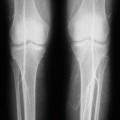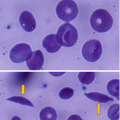(1)
Department of Surgery, Dar A lAlafia Medical Company, Qatif, Saudi Arabia
12.1 Introduction
Patients with sickle cell anemia (SCA), often present with abdominal pain, which is usually attributable to SCA abdominal vaso-occlusive crisis, and based on this, conservative therapy is advocated in the majority of patients with SCA who present with acute abdominal pain.
This however does not exclude the possibility of other common surgical conditions, namely, cholelithiasis, acute cholecystitis, peptic ulcer disease, and acute appendicitis which may be difficult to differentiate clinically from simple abdominal vaso-occlusive crisis.
Acute appendicitis remains the most common cause of acute abdomen requiring emergency abdominal operation. This however may not be the case in patients with SCA, where acute appendicitis is reported not only to be rare but also has a rapid course with a high incidence of perforation (Fig. 12.1).

Fig. 12.1
Abdominal CT scan showing acute perforated appendicitis with abscess formation
Acute appendicitis in patients with SCA has been reported not only to be rare but also different.
The reason for this low incidence of acute appendicitis in patients with SCA is not exactly known.
Based on this and the risks associated with surgery and anesthesia, it is advocated to limit surgical exploration to those with clear evidence of potential surgical pathology or progressive findings during a period of observation.
12.2 Pathology
The exact pathogenesis of acute appendicitis is not known, and inflammation is often said to be precipitated by obstruction, but in a large number of acutely inflamed appendices, there was no evidence of luminal obstruction.
About 15–25 % of appendices removed from patients with suspected appendicitis appear normal on histologic examination.
This however may not be the case always as new distinct pathological entities have now emerged in those with clinically suspected acute appendicitis but normally looking appendix at the time of surgery.
These include neurogenic appendicopathy, a disease caused by proliferation of nerve fibers and hyperplasia of endocrine cells in the submucosa of the appendix, and pathological changes of the epithelium and lymphatic tissue of the appendix. This may explain the dramatic symptomatic relief following appendectomy in those with clinically diagnosed acute appendicitis but negative appendectomy.
Stay updated, free articles. Join our Telegram channel

Full access? Get Clinical Tree







